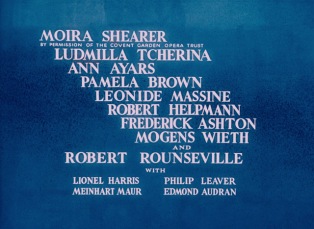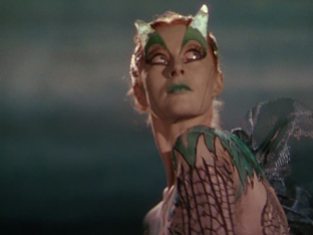
The use of Technicolor has been well documented in the great body of literature surrounding film history. While it was used in film studios in the United States, its use certainly extended beyond the States. Many film aficionados are familiar with the British creative team of Michael Powell and Emeric Pressburger, known as “The Archers,” and their beautiful use of technicolor in The Red Shoes (1948). Audiences were intrigued by how Technicolor photographed in Britain, as England’s drearier weather created a soft, gauzy glow to its Technicolor productions. Though The Red Shoes is revered by many as a key Technicolor production and also happens to star skilled ballerina Moira Shearer, The Tales of Hoffmann (1951) is a spectacular albeit underrated film produced by The Archers.

The Tales of Hoffmann is a film adaptation of Jacques Offenbach’s opera, starring Robert Rounseville, Moira Shearer, Robert Helpmann and Léonide Massine, and features Pamela Brown, Ludmilla Tchérina and Ann Ayars. Interestingly, Shearer, Helpmann, and Tchérina had previous experience working for The Archers in The Red Shoes, three years prior to the release of The Tales of Hoffmann. All actors were dubbed except for Rounseville and Ayars. Dorothy Bond, Margherita Grandi, Monica Sinclair and Bruce Dargavel are the featured singers in this film, and the Royal Philharmonic Orchestra accompanies them.
The entire opera was pre-recorded prior to filming in order to create the soundtrack. The film was then edited to match the rhythms of the music. There is no dialogue in this film.
The opera is divided into five parts: the Prologue, First Tale, Second Tale, Third Tale, and Epilogue. Each individual tale depicts the three great romances in the life of the poet-hero, shown through a set of flashbacks. Hoffmann’s struggles between human love and dedication to his work. Though neither romance succeeds, Hoffmann reshapes his failed relationships into art.
In the Prologue, Hoffmann (Robert Rounseville) attends a performance by Stella (Moira Shearer), a prima ballerina dancing in “The Enchanted Dragonfly Ballet.” In this dreamlike ballet, Stella takes on the role of a dragonfly who kills her mate. Stella soon sends Hoffmann a note asking him to meet her after the performance. Unfortunately, the note is intercepted by his rival, Councillor Lindorf. Unaware of the invitation from Stella, Hoffmann goes to a tavern instead. There, he tells the story of a clown, Kleinzach, and recounts three stories of his past loves—Olympia, Giulietta and Antonia—and drinks heavily. His three stories are his tales, as the title suggests.

In the First Tale, Olympia (Moira Shearer) is an automaton invented by scientist Spalanzani (Léonide Massine) and magic spectacle maker Coppelius (Robert Helpmann). Hoffmann falls for the doll, unaware of her being an invention. While he falls in love with her as an ideal woman, things fall apart–including Olympia herself.
In the Second Tale, Hoffmann falls for a woman named Giulietta (Ludmilla Tchérina). However, she does not intend to pursue a romance with Hoffmann; instead, she aims to seduce him in order to steal his reflection for a magician (Robert Helpmann).
The Third Tale features Antonia (Ann Ayars), a soprano suffering from an incurable illness. She is not allowed to sing, but the evil Dr. Miracle forces her to do so. She dies, which leads to more heartbreak for Hoffmann.
In the Epilogue, Hoffmann shares that Olympia, Giulietta, and Antonia each exemplify different and symbolic aspects of love. As his tales end, Stella encounters Hoffmann once again, but I will encourage my readers to view the film to see what happens during their reunion.

The Tales of Hoffmann is a visually stunning film, garnering Oscar nominations for Best Art Direction-Set Decoration and Best Costume Design–both by Hein Heckroth. Each tale showcases a specific primary color to complement the tone of the given tale: “The Tale of Olympia” features bright yellows; “The Tale of Giulietta” uses dark reds; and “The Tale of Antonia” uses varying shades of blue. Despite these creative touches, the film lost in both categories to An American in Paris (1951).
The Tales of Hoffmann is a visual gem that is not to be missed. In fact, even Cecil B. DeMille lauded Powell and Pressburger in a note, stating, “For the first time in my life, I was treated to Grand Opera where the beauty, power and scope of the music was equally matched by the visual presentation.” I highly encourage film fans to enjoy this spectacular retelling of an opera and to enjoy the noteworthy work of Powell and Pressburger, as well as the phenomenal cast.


This post is part of the Classic Movie Blog Association’s Spring Blogathon, entitled, “Underseen and Underrated.” To access more information and read accompanying posts, please click on the following banner:











































I always enjoyed the opera, and I didn’t realize there was a film version. It sounds like the visuals here really enhance the fantastic and surreal elements of the story, which is certainly expected from Powell & Pressburger. Thanks for highlighting this — next time I want to enjoy a film opera, I’ll know what to seek out!
Wow – finally a film spotlighted in this blogathon that I’ve seen! I agree this is a simply beautiful film – truly unique. Your post, too was beautiful and your choices of photos breathtaking. Nice job!
Someone — it might have been Martin Scorsese — said you can’t go wrong with any movie that begins with that iconic target and arrows. Excellent write-up!
A terrific tribute to one of Powell and Pressberger’s lesser-known films! It was undoubtedly one of their most challenging and, as with all of your work, is definitely worth watching. Your photos are sumptuous.